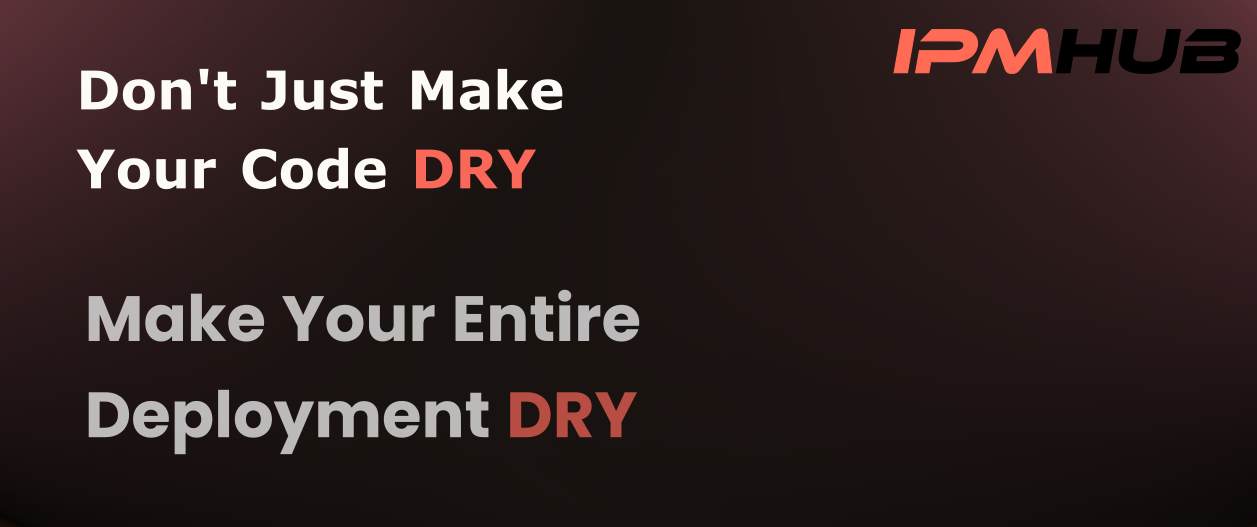I have to be honest - while many of us have gotten better at writing DRY (Don't Repeat Yourself) infrastructure code, I still see room for improvement.
As someone who's spent years in the trenches of infrastructure automation, I've noticed an interesting paradox in our industry. While we've made impressive strides in making our Infrastructure as Code (IaC) more modular and reusable, we often stop there. But why?
The Current State of IaC: A Half-Finished Symphony 🎵
Your infrastructure code is just one instrument in the orchestra of deployment.
What about the rest of the ensemble?
- CI/CD pipeline definitions
- Deployment scripts
- Parameter files
- Configuration templates
- Testing frameworks
Too often, these critical components are treated as afterthoughts, copied and pasted between projects with minimal standardization. Sound familiar?
The Hidden Costs of Partial DRY
In my conversations with cloud engineers and DevOps teams, I keep seeing the same pattern: beautifully modular IaC surrounded by a wilderness of duplicated deployment scripts and pipeline configurations. This creates several problems:
- Inconsistent Deployments: Each team reinvents the wheel, leading to different deployment patterns even when using the same infrastructure modules
- Security Risks: Junior engineers copy-pasting pipeline configurations often miss critical security checks
- Maintenance Nightmare: When you need to update deployment practices, you have to hunt down every variation across your organization
Enter Complete Deployment DRY with IPM
This is exactly why we built IPM (Infrastructure Package Manager) - to extend the DRY principle beyond just infrastructure code. Here's what true deployment DRY looks like:
# A typical IPM package structure
.
├── packages # <-- a set of IaC packages
│ ├── network-security-groups
│ ├── route-tables
│ └── virtual-networks
│ ├── packages
│ │ └── utl-common-types
│ ├── subnet
│ └── virtual-network-peering
├── pipelines # <-- A set of preconfigure pipelines
│ ├── azdo
│ │ ├── jobs
│ │ └── stages
│ ├── github
│ └── scripts
└── starterKit # <-- contains scripts and other files like preconfigured variable files.
When you use IPM to manage your deployments, you're not just getting the Bicep or Terraform modules - you're getting the entire deployment context. It's like having a deployment cookbook that ensures consistency across your organization or customers.
Real World Impact
Let me share a recent example. During the onboarding of a new customer that was managing around 10 different Azure tenants. Despite using standardized Bicep modules, they were dealing with:
- 7 different variations of deployment pipelines
- Inconsistent parameter handling across customers
- No centralized way to maintain their deployment templates
After implementing IPM and embracing full deployment DRY:
* Deployment consistency improved by almost 90%
* Pipeline maintenance time reduced by 60%
* Time to onboard a solution to a new customer reduced from hours to less than 5 minutes
Making the Shift
Ready to take your DRY principles to the next level? Here's where to start:
- Audit Your Current State: Look beyond your IaC. How many variations of deployment pipelines do you have?
- Standardize: Create template pipelines that can be reused across projects
- Package Complete Solutions: Use IPM to distribute not just your infrastructure code, but complete deployment solutions
The Future is Fully DRY
The future of infrastructure automation isn't just about writing cleaner IaC - it's about creating complete, reusable deployment experiences. When we extend DRY principles across the entire deployment pipeline, we're not just saving time - we're building more reliable, secure, and maintainable systems.
Remember: Your infrastructure code is only as good as its deployment pipeline. Make them both DRY, keep them up-to-date.
Want to learn more about implementing complete deployment DRY? Check out our documentation at docs.ipmhub.io or reach out to me directly on LinkedIn. Let's make infrastructure automation better, together.
